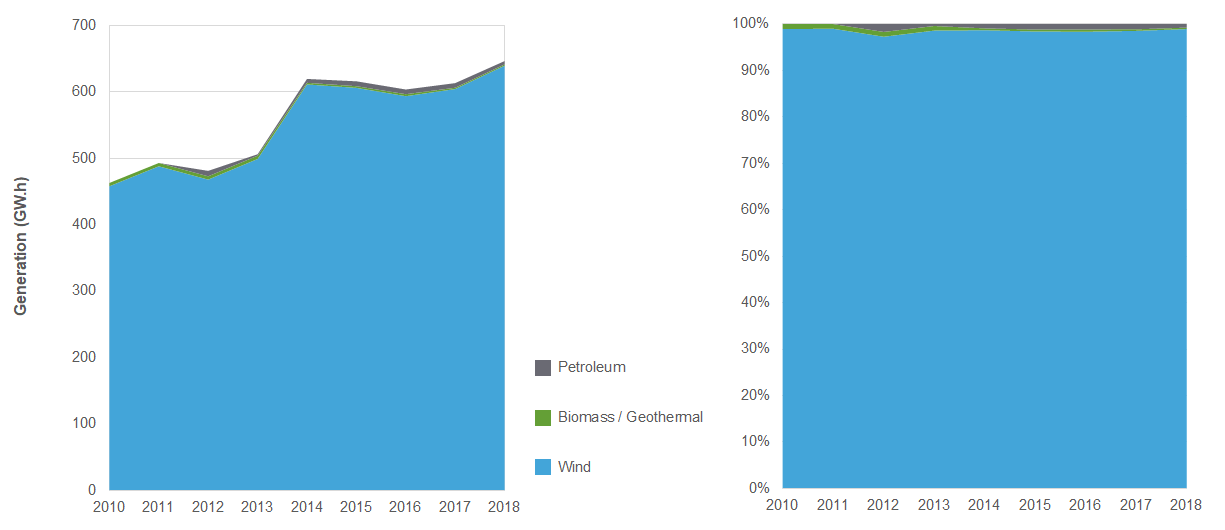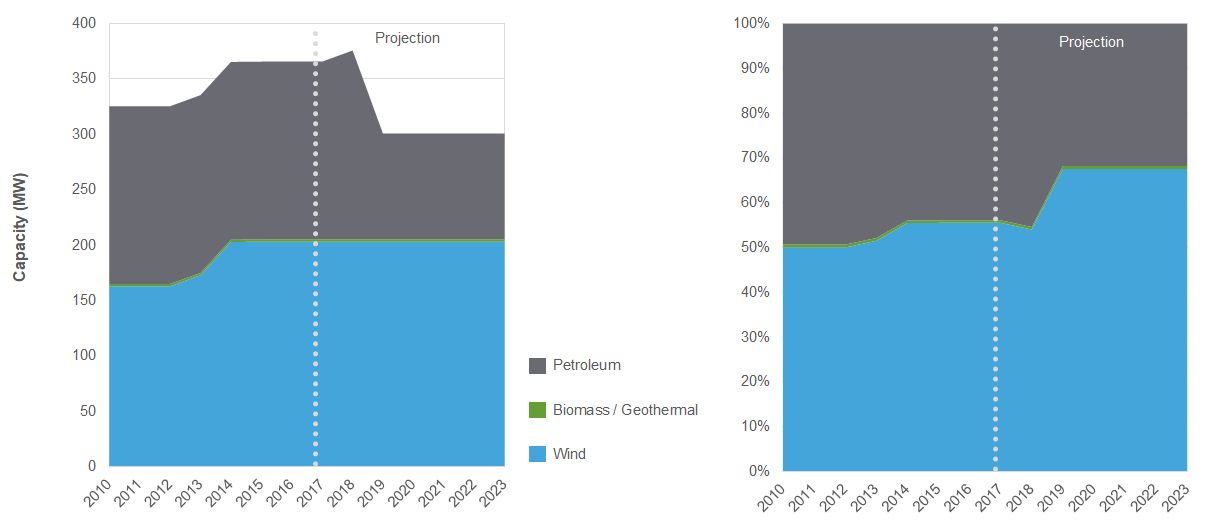Canada's Renewable Power – Prince Edward Island

Prince Edward Island

Prince Edward Island (PEI) generates the majority of its electricity from wind. However, the island is also a significant importer of electricity from New Brunswick.
Generation Trends
In 2018, 99.2% of electricity generated in PEI was renewable, almost all of it from wind. PEI has the highest percentage of its total electricity generation from wind than any other province or territory. PEI, along with Nunavut, are the only two jurisdictions in Canada that do not generate any electricity from hydro. Total renewable generation in 2018 was 642 gigawatt-hours (GW.h).
PEI imports about 75% of its consumed electricity from New Brunswick. In 2017, two new sub-sea cables were installed across the Northumberland Strait, increasing the island’s import capacity from 200 megawatts (MW) to 560 MW.
Oil and diesel generation in PEI is primarily for emergency back-up and peaking. Total thermal generation in 2018 was five GW.h, or 0.8% of total generation.
Total electricity generation in PEI grew from 463 GW.h in 2010 to 647 GW.h in 2018. Changes in PEI’s electricity generation mix are illustrated in Figure 1.
Figure 1. Electricity Generation in PEI

Source and Description
Source: CER – Canada’s Energy Future 2020 (EF2020)
Description: This graph illustrates electricity generation from 2010 to 2018 in PEI. In 2010, PEI’s total generation was 463 GW.h (100% renewable). In 2018, total generation was 647 GW.h (99.2% renewable).
GHG Emissions from Electricity Generation
In 2018, PEI’s electricity sector emitted 0.0 megatonnes of carbon dioxide equivalent (MT of CO2e). PEI’s generation intensity was 4.0 grams of CO2e per kilowatt-hour.
PEI produced 0.0% of Canada’s total greenhouse gas emissions from electricity generation in 2018.
Recent and Projected Capacity Changes for Renewables
Between 2010 and 2017, PEI added a net 40 MW of renewable capacity, entirely in the form of wind. Between 2017 and 2023, PEI is projected to add no new renewable capacity and phase out 65 MW of petroleum-fired capacity. These capacity changes are illustrated in Figure 2 with data provided in Table 1.
Figure 2. Electricity Capacity and Future Changes in PEI

Source and Description
Source: CER – EF2020
Description: This graph illustrates historical electricity capacity from 2010 to 2017 in PEI and the CER’s projection of future capacity changes from 2018 to 2023. In 2010, PEI’s total installed electricity capacity was 326 MW (50.7% renewable). In 2017, capacity had grown to 366 MW (56.1% renewable). By 2023, total capacity is projected to grow to 376 MW (54.6% renewable).
Table 1. Electricity Capacity (2010 – 2023) and Generation (2010 and 2018) in PEI
| Capacity in MW and % | Generation in GW.h and % | ||||||
|---|---|---|---|---|---|---|---|
| 2010 | 2017 | 2018 | 2020 | 2023 | 2010 | 2018 | |
| ---------- Projected ---------- | |||||||
| Wind | 163 | 203 | 203 | 203 | 203 | 458 | 640 |
| 50.1% | 55.6% | 54.1% | 67.6% | 67.6% | 98.9% | 98.9% | |
| Biomass / Geothermal | 2 | 2 | 2 | 2 | 2 | 5 | 2 |
| 1.3% | 1.0% | 1.0% | 1.0% | 1.0% | 1.1% | 0.3% | |
| All Renewable Sources | 165 | 205 | 205 | 205 | 205 | 463 | 642 |
| 50.7% | 56.1% | 54.6% | 68.3% | 68.3% | 100.0% | 99.2% | |
| Oil and Diesel | 160 | 160 | 170 | 95 | 95 | 0 | 5 |
| 49.3% | 43.9% | 45.4% | 31.7% | 31.7% | 0.0% | 0.8% | |
| All Thermal Sources | 160 | 160 | 170 | 95 | 95 | 0 | 5 |
| 49.3% | 43.9% | 45.4% | 31.7% | 31.7% | 0.0% | 0.8% | |
| All Sources | 326 | 366 | 376 | 301 | 301 | 463 | 647 |
- Date modified:
